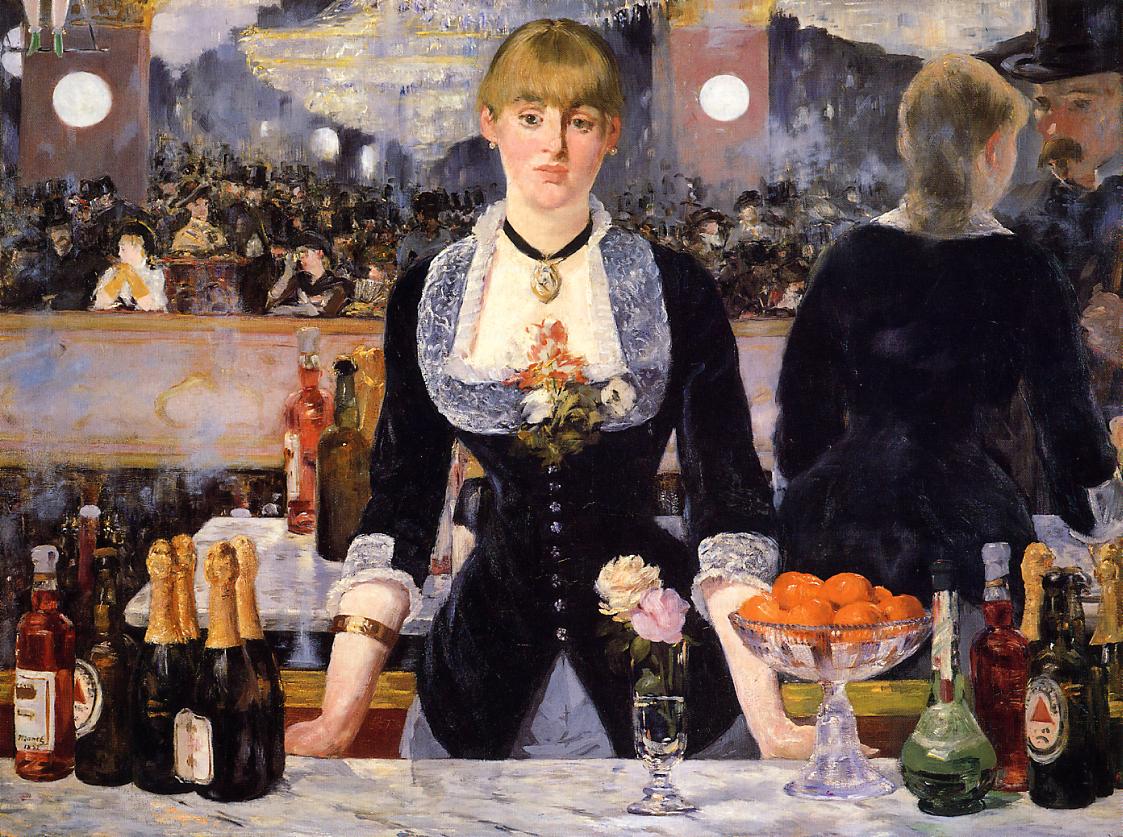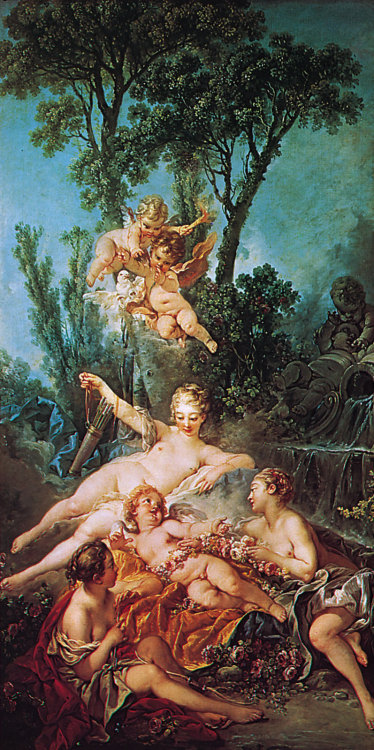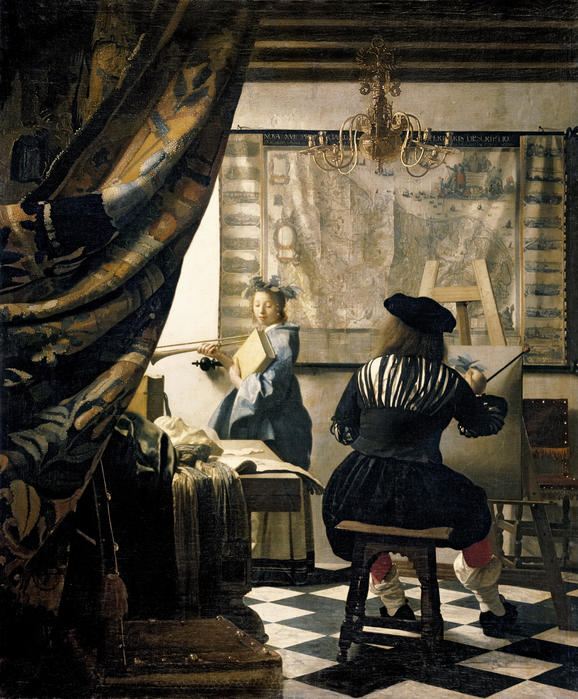Palak's Art World
Monday, December 3, 2012
Edouard Monet's A Bar at the Folies-Bergere.
This painting was painted by Edouard Monet called A Bar at the Folies-Bergere. It was painted in 1882 and it was oil on canvas. It is about 3 X 4 feet and found in Courtauld Institute of Art Gallery, London. The setting of the painting is in a Parisian Cafe. This painting reminds of some of the painting that were analyzed in previous chapter. The artist is shown in the canvas through a use of a mirror. It is a debate whether the guy shown in the mirror, at the upper right corner, is artist himself or a customer. The facial expressions of the barmaid seems disinterested and lost in her own world. She is quite detached from the world surrounding her. The background is blurred and just like Impressionism style the strokes are not refined and the painting does not show any enhancement. This style in the painting brings focus on the barmaid due to the unclear background.
Claude Monet's Impression: Sunrise.
This is a painting by Claude Monet called the Impression: Sunrise. It was painted in 1872 and it was oil on canvas. It is approximately 2 X 2 feet. This painting was called Impressionism because of the brushstrokes and quality of the sketch. It was a different style compare to the Renaissance, Baroque and other. The style was named Impressionism which incorporates "the quality of sketches--abbreviation, speed, and spontaneity" (Kleiner 801). The strokes in this painting are not attempted to blend so create a smooth look. The subjects in the painting are blurry and does not provide an accurate illustration of the view. In this style of painting, the canvas portrays the mixture of what artist saw and what he/she felt. Neither is it completely objective descriptions nor exclusively subjective perspective. It was a combination of objective and subjective. Impressionism was also different from other styles because it was one of the first style that was painted in the outside world and not in a studio.
Friday, November 30, 2012
Fuseli's The Nightmare
This portrait was painted by Henry Fuseli and it is called The
Nightmare. It is oil on canvas, painted in 1781, and it is 4 X 4 feet. Fuseli
is self-taught and expresses the fantasies of his innovative imagination in a
distinct manner. The themes of Fuseli’s painting are dark fantasies and
atmosphere of horror. In this portrait, a young woman is asleep across a bed
while her limp arm is dangling outside the bed. On her body, an incubus is
settled threateningly. During Medieval times, it was believed that a demon
called incubus preyed sexually on sleeping women. The ghostly horse in the
background bursts into the scene from behind the curtain. The title of the
painting nightmare urges the viewer
to imply it is due to the presence of the horse. However, the title is derived
from “night” and “Mara”. Mara was a spirit, which tortured and suffocated
sleepers. The illustration of the dark side of the human sub consciousness was first
attempted by Henry Fuseli.
Wednesday, November 28, 2012
Antonio Canova's Pauline Borghese as Venus
Antonio Canova painted Pauline Borghese as Venus in 1808. It was made out of marble and it is six and half feet long. It is in Galleria Borghese, Rome. It is a marble statue inspired by classical models. Canova is renowned artist for his classical gods and heros sculptures. In this portrait, Canova has depicted Napoleon's sister. Although Canova wanted to depict Pauline Borghese as the goddess of the Hunt, Diana, Borghese desired to be portrayed as Venus, goddess of love. Borghese is seen holding golden apple which is symbol of the goddess's victory in the judgement of Paris. She is shown as lying on a divan and gracefully holding her posture. This portrait was never got to be admired by Canova's fans due to the gossips of Pauline Borghese's affairs. Due to the gossips, Prince Camillo Borghese kept the sculpture isolated in his Villa. However, the existence of the sculpture was widespread and the artist and subject are disgraced.
Monday, November 12, 2012
Francois Boucher's Cupid a Captive.
This portrait called Cupid a Captive was painted by
Francois Boucher. It was painted in 1754 and it is oil on canvas. Due to being
favorite artist of Madame de Pompadour, Francois Boucher became famous in
French painting. He achieved success due to his graceful painting of spiritual
symbols and figures in narrow valley covered in pink and sky-blue light. The
infant, cupid, and the females create a pyramid on cool, leafy background
covered with draperies. The draperies covers and reveals the nudity of the cupid
and the female figures. This mastery piece was created by a mixture of Italian
and French Baroque devices such as crisscrossing diagonals, curvilinear lines,
and recessions. Boucher portrays sensuality and playfulness at the same time. It
is a vibrant and jovial Rococo painting style, which uses pastel colors.
Fragonard's The Swing.
This painting is by Jean- Honore Fragonard, greatest student of Boucher, called The Swing. It was painted in 1766 and it is oil on canvas. It shows an old bishop, convinced by a young man, swinging a young lady higher and higher. The young woman's lover is admiring her earnestly while sitting in the left hand corner of the painting. The woman is flirtatiously swinging her shoe toward the statue of cupid. The young lady is the focal point as the old bishop and the young man are both looking towards her. It shifts viewer attention toward the young lady. Because her shoe in the air is pointing toward the cupid, it makes the cupid part of the focal point along with the young lady. The finger on his lips of cupid statue can be interpreted as gesturing to be quiet and keep the peaceful environment. The soft light and glowing colors portrays sensuality in the theme. This portrait is an example of Fragonard’s work and late Rococo painting style.
Friday, November 9, 2012
Jan Vermeer's Allegory of Art of the Painting
This portrait is painted by Jan Vermeer called Allegory of Art of the Painting. It was painted in 1670-1675 and it is oil on canvas. Vermeer appears in the painting. His back is toward the viewer and dressed in historical clothes. The artist is deeply engrossed in his work at painting a model that is standing in front of him wearing laurel wreath and holding a book in one hand and trumpet in another. They are traditional features of Clio, the muse of history. Another history reference in the painting is the map on the back wall. Similar to other Vermeer’s painting, in Allegory of Art of the Painting the viewer is outside the space of action. Viewer is looking from the drawn curtains, which separates the artist’s studio and the house. Also the hidden window is radiating light on the painting and the model and illuminates that area. This painting was construed as an allegory by scholars and confirmed by Vermeer’s mother-in-law.
Subscribe to:
Posts (Atom)






